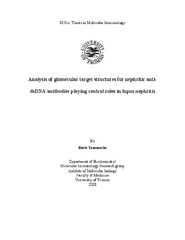Analysis of glomerular target structures for nephritic anti-dsDNA antibodies playing central roles in lupus nephritis
Permanent lenke
https://hdl.handle.net/10037/12741Dato
2008-05Type
Master thesisMastergradsoppgave
Forfatter
Tømmerås, BeritSammendrag
Systemic lupus erythematosus is an autoimmune disease characterized by the presence of autoantibodies towards nuclear antigens. Sub-populations of anti-dsDNA antibodies have the potential to bind in the kidney and thereby induce nephritis, but there is no definite distinction that separates non-pathogenic from pathogenic antibodies. There must be parameters that determine anti-dsDNA antibody binding, and properties as high affinity and specificity for dsDNA, cross-reactivity with inherent renal molecules, and availability for target antigens have been suggested as possible candidates.
In this study pre-characterized sub-populations of purified monoclonal anti-dsDNA antibodies (mAbs) were injected into BALB/c mice. To trace the glomerular targets for the antibodies, immunological microscopy at an ultrastructural level were performed, and proteinuria and serum levels of mAbs were monitored.
All tested anti-dsDNA mAbs had the potential to deposit in glomeruli, even in healthy mice. This lead to the assumption, that nephritic potential may not be connected to structural characteristics of particular anti-dsDNA antibody sub-populations. It seem like anti-dsDNA antibodies in general, and not specific sub-populations, are involved in development of lupus nephritis.
There are growing evidence for nucleosomes to be the inducer and target for anti-dsDNA antibodies, and if availability of nucleosomes is the critical parameter for developing glomerulonnephritis, there are no need to consider whether there exist particular pathogenic antibody subpopulations.
Forlag
Universitetet i TromsøUniversity of Tromsø
Metadata
Vis full innførselSamlinger
Copyright 2008 The Author(s)
Følgende lisensfil er knyttet til denne innførselen:


 English
English norsk
norsk